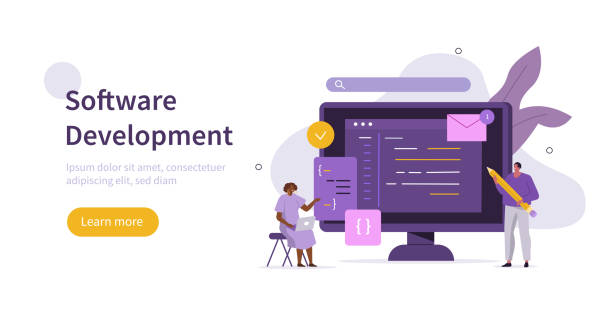The Importance of Secure Website Design in the Digital Age

In today’s world, where businesses and individuals are increasingly present in the online space, #WebsiteSecurity has become more important than ever.
Secure website design is no longer a luxury option, but an indispensable necessity for every online entity.
Without sufficient attention to security measures, your website can easily become a target for cyber-attacks, which can have irreparable consequences, including the loss of sensitive data, damage to brand reputation, and even extensive financial losses.
The importance of secure website design is vital not only for protecting user information but also for the long-term sustainability and success of a business.
This section explains the ‘why’ and the high importance of this issue.
The increasing complexity of cyber-attacks and the diversity of infiltration methods emphasize the need to invest in secure website design.
Hackers are constantly inventing new ways to circumvent security systems, which requires website administrators and developers to always be one step ahead.
Users’ personal data, financial and commercial information, and even confidential government information are all at risk.
For example, a successful attack to steal customers’ credit card information can not only damage your business’s reputation but also lead to heavy legal penalties and a lack of public trust.
This section of the article delves into the news and analytical aspects of the importance of web security, aiming to raise thought-provoking content about the consequences of neglecting security.
In addition to financial and reputational aspects, legal responsibility is also at stake.
Many countries and international bodies have enacted strict laws regarding the protection of personal data (such as GDPR in Europe).
Failure to comply with these laws can lead to severe penalties.
Therefore, securing a website is not only a technical measure but also a legal and ethical imperative.
In this regard, continuous training for the development team and updating their knowledge on the latest threats and best security practices are of paramount importance.
A website not designed with a security approach from the outset is like a house built without strong foundations, which will collapse at the first storm.
Therefore, the foundations of secure website design must be laid from the initial stages of the project, and not as an additional section at the end.
For more information on web security principles, you can refer to reputable online sources like Wikipedia.
Are you tired of your company’s website not meeting your expectations? Design a professional website with Rasawb that truly represents your business.
✅ Increase new customer acquisition and sales leads
✅ Enhance your brand’s credibility and trust with your audience
⚡ Get a free website design consultation!
Common Vulnerabilities and Cyber Attacks

Understanding #CommonVulnerabilities and types of cyber-attacks is the first step in secure website design.
Hackers use various methods to infiltrate systems, and knowing these methods helps developers implement appropriate defenses.
This section introduces the most common threats in an educational and specialized manner.
One of the most common attacks is SQL Injection.
In this attack, the attacker injects malicious SQL code into the database through website inputs, which can lead to data disclosure, alteration, or deletion.
Cross-Site Scripting (XSS) attacks are also very common; in this method, malicious client-side code (usually JavaScript) is injected into the website and executed in the victim’s browser, which can lead to the theft of cookies, session information, and even redirection of users to phishing sites.
Cross-Site Request Forgery (CSRF) attacks are another type of threat where an attacker tricks a user into sending unwanted requests to a website they are already logged into.
These attacks can cause password changes, fund transfers, or other unintended actions.
DDoS (Distributed Denial of Service) attacks overload the server with a massive volume of traffic, causing service disruption and preventing real users from accessing the website.
These attacks are usually carried out by a network of infected computers (botnets) and can cause significant financial and reputational damage.
In addition to these, weak authentication and session management, the use of vulnerable components (such as outdated libraries and plugins), incorrect server security configurations, and the disclosure of sensitive information through programming errors are also common vulnerabilities that affect website security.
In the following sections, guidance for countering these threats will be provided.
Phishing attacks, although not directly attacking the website, can redirect users to fake pages of your website and steal their information.
Awareness of these threats and countermeasures is an integral part of the process of building a secure website.
For example, to counter SQL Injection, using Prepared Statements and parameterized inputs is essential.
For XSS, all user inputs must be filtered and encoded before display.
For CSRF, using CSRF tokens in forms is an effective solution.
Each of these attacks requires a deep understanding and implementation of specialized solutions, which will be explained in detail later to move further towards a secure website design.
Basic Security Protocols and Prerequisites

To achieve #SecureWebsiteDesign, adherence to basic security protocols and prerequisites is of particular importance.
This section provides practical and specialized guidance on implementing these requirements.
The first and most important step is to use HTTPS instead of HTTP.
HTTPS, using an SSL/TLS certificate, encrypts the communication between the user’s browser and the website server, preventing eavesdropping, tampering, or theft of data during transmission.
This is not only vital for your website security but also positively impacts your SEO ranking in search engines like Google.
This is a fundamental and essential step for any website.
In addition to HTTPS, proper management of user and administrator passwords is of high importance.
Encouraging users to use strong and complex passwords, storing passwords as hashes (not in plain text), and implementing Two-Factor Authentication (2FA) for logging into administrative panels and user accounts can significantly prevent Brute Force attacks and account theft.
Regular updates of all software, frameworks, plugins, and Content Management Systems (CMS) like WordPress or Joomla is another key principle of secure website design.
Many cyber-attacks are carried out through known vulnerabilities in older software versions, which can be prevented by timely updates.
Correct security configurations of the web server (such as Apache or Nginx) and server operating system (such as Linux) are also part of the basic requirements.
Disabling unnecessary services, configuring firewalls, and applying the principle of Least Privilege for files and directories are among the measures that should be considered.
Also, implementing HTTP security headers such as Content Security Policy (CSP), X-XSS-Protection, X-Frame-Options, and Strict-Transport-Security (HSTS) can significantly help enhance website security.
These headers instruct the browser on how to load website content and prevent various attacks such as XSS and Clickjacking.
In the context of secure website design, understanding and implementing these basic principles is not just a preventive measure but provides a strong foundation for your website’s overall security structure.
This explanatory and guiding approach helps website administrators and developers view security with a more comprehensive perspective.
The following table summarizes these initial requirements for securing a website.
| Priority | Security Step | Description |
|---|---|---|
| 1 | Use HTTPS | Encrypting traffic between user and server with SSL/TLS |
| 2 | Strong Password and 2FA | Encouraging complex passwords and two-factor authentication |
| 3 | Software Updates | Keeping CMS, frameworks, and plugins up-to-date |
| 4 | Secure Server Configuration | Firewall settings, least privilege, and disabling unnecessary services |
| 5 | HTTP Security Headers | Implementing CSP, HSTS, and other headers |
Backend and Database Security

#BackendSecurity and database security are fundamental pillars of secure website design.
The backend is where the main application logic, database interaction, and processing of sensitive data occur.
Therefore, any vulnerability in this layer can lead to catastrophic consequences.
This section specifically and descriptively addresses solutions for securing this area.
One of the most important measures is preventing SQL injection attacks.
As mentioned earlier, using Prepared Statements and ORM (Object-Relational Mapping) instead of building SQL queries directly from user inputs is highly recommended.
These methods ensure that user inputs are interpreted as data and not as part of SQL commands.
Database security extends beyond SQL Injection.
Database access should be restricted using the principle of Least Privilege; meaning that each database user (or each part of the application) should only have access to the information essential for its operation.
Encrypting sensitive data in the database, such as credit card information or national identification numbers, prevents its disclosure even if the database is compromised.
Using secure database management tools, regularly updating the Database Management System (DBMS), and monitoring database logs to identify suspicious activities are other essential measures for securing a website from the backend.
Furthermore, reviewing and filtering all user inputs (Input Validation) on the server-side, before processing or storing, is crucial.
This prevents various attacks such as code injection, XSS (if data is displayed again), and even logical attacks.
Also, proper Error Handling is vital to prevent the disclosure of sensitive system information to attackers.
Error messages should not reveal excessive technical details (such as file paths, software versions, or database information).
Only general and user-friendly information should be displayed.
Secure website design requires that all backend interactions with external resources (such as third-party APIs) are also carefully reviewed and that secure protocols and proper authentication are used.
Server-level firewall configurations, using a VPN for administrative access, and limiting access to server ports all contribute to strengthening backend security.
The more robust the backend layer, the lower the risk of successful attacks on your secure site.
In this section, the analytical approach to backend security issues and their implementation provides useful guidance.
Did you know 85% of customers check your company’s website before any interaction?
With Rasawb, build a corporate website that reflects your credibility.
✅ Increase credibility and customer trust
✅ Attract high-quality leads
⚡ Get a free website design consultation
Frontend Security and Input Validation

#FrontendSecurity, although not directly related to server data access, plays a very important role in preventing client-side attacks and improving overall secure website design.
This section discusses methods for ensuring security in this layer in an educational and specialized manner.
One of the main threats in the frontend is Cross-Site Scripting (XSS) attacks.
To counter XSS, all data sent from the server to the frontend and displayed on HTML pages must be properly encoded.
This ensures that the browser does not interpret special characters (like < and >) as part of the HTML code, but rather displays them as normal text.
In addition to output encoding, client-side input validation (JavaScript) is also important.
Although server-side validation (discussed in the backend section) is more essential and critical, client-side validation can improve the user experience and prevent invalid data from being sent to the server.
However, client-side validation should never be solely relied upon, as attackers can easily bypass it.
For building a secure website, both types of validation complement each other.
Clickjacking attacks are another frontend threat where an attacker places an invisible layer (iframe) over your website to trick the user into clicking on malicious elements.
To prevent these attacks, the HTTP security header called X-Frame-Options can be used, which instructs the browser not to allow your website to be loaded in an iframe.
Using Content Security Policy (CSP) is another powerful tool to control the resources that the browser can load (such as scripts, images, stylesheets, etc.).
CSP can significantly reduce the risk of XSS and code injection attacks and contribute to website security.
Proper management of cookies and session information (Session Management) on the frontend is also important.
Sensitive cookies should be set with Secure (only sent over HTTPS) and HttpOnly (not accessible via JavaScript) flags to prevent their theft by XSS attacks.
Also, ensuring that all JavaScript libraries and frameworks used (such as jQuery, React, Vue) are up-to-date and free from known vulnerabilities is an integral part of secure website design.
By observing these points, the frontend layer can be well protected, preventing many security issues.
Authentication and User Session Management

#Authentication and #SessionManagement are two main pillars in secure website design that allow users to securely log in and perform their authorized activities.
This section provides guiding and specialized best practices in this area.
The first step in authentication is to ensure the security of the login process.
This includes using HTTPS for all login and registration pages, and precise validation of user credentials on the server side.
Implementing Two-Factor Authentication (2FA) or Multi-Factor Authentication (MFA) for users, especially for high-privilege accounts, is highly recommended.
This provides an additional layer of security, even if the user’s password is compromised.
Secure storage of user passwords is of vital importance.
Never store passwords in plain text.
Instead, use strong and brute-force resistant hashing algorithms like Argon2, bcrypt, or scrypt, which are applied with a unique “salt” for each password.
Salting ensures that even if two users have the same password, their hashes will be different, preventing Rainbow Table attacks.
Additionally, policies for strong passwords should be enforced, such as minimum length, and the use of a combination of uppercase and lowercase letters, numbers, and symbols.
Session Management is another key aspect of website security.
User sessions should have a limited lifespan and automatically expire after a period of inactivity.
This prevents abuse of open sessions in case of unauthorized access to the user’s device.
Session IDs should be random, unpredictable, and sufficiently long to prevent Session Fixation and Session Hijacking attacks.
These IDs should only be sent over HTTPS and with the HttpOnly flag in cookies to prevent JavaScript access to them and XSS attacks.
When a user logs out, their session should be completely invalidated on the server side.
This action ensures that even if someone gains access to the session cookie, they cannot use it to log back into the account.
Furthermore, implementing rate limiting for failed login attempts can prevent Brute Force attacks.
The stronger the authentication and session management systems, the more robust your secure website design will be from the ground up, and the user experience will be significantly safer.
For more details on authentication, you can refer to Wikipedia.
Continuous Monitoring and Security Audit

#ContinuousMonitoring and #SecurityAudit are integral parts of the secure website design process.
Creating a secure website is only the beginning; its continuous maintenance and updating to counter new threats are of paramount importance.
This section analytically and instructively addresses the importance of this topic.
Websites should be regularly scanned for vulnerabilities.
Using web vulnerability scanning tools (such as OWASP ZAP or Acunetix) can help identify common weaknesses.
Also, conducting Penetration Testing by independent security teams, who attempt to infiltrate the system like a real attacker, can reveal more complex and logical vulnerabilities.
Log Monitoring is one of the crucial tools for identifying suspicious activities.
All important activities, including failed login attempts, access to sensitive files, changes in security settings, and system errors, should be logged and regularly reviewed.
SIEM (Security Information and Event Management) tools can help collect, analyze, and correlate logs from various sources and issue real-time security alerts.
This allows you to quickly respond to security incidents and prevent damage from spreading.
This continuous monitoring greatly contributes to website security.
Implementing a Web Application Firewall (WAF) can also act as a first line of defense against many common web attacks like SQL Injection and XSS.
A WAF analyzes incoming and outgoing website traffic and blocks suspicious requests.
Furthermore, having an Incident Response Plan for when a successful attack occurs is vital.
This plan should include steps for identification, containment, eradication, recovery, and lessons learned.
Without a defined plan, responding to security incidents can be chaotic and ineffective.
Regularly updating security programs and staying aware of the latest cyber threats and attacks is also of high importance.
Participating in security forums, following specialized blogs, and attending training courses help your security team always stay one step ahead of attackers.
This analytical and guiding approach ensures that your secure website design is not a static process, but a continuous cycle of improvement and adaptation to the evolving threat environment.
The table below lists important tools for security monitoring and auditing for a secure website.
| Tool Type | Main Use | Examples |
|---|---|---|
| Web Vulnerability Scanner | Automated identification of known weaknesses in websites | OWASP ZAP, Acunetix, Burp Suite |
| Web Application Firewall (WAF) | Filtering malicious traffic and protecting against common web attacks | ModSecurity, Cloudflare WAF, Sucuri WAF |
| Security Information and Event Management System (SIEM) | Collecting, correlating, and analyzing security logs | Splunk, ELK Stack (Elasticsearch, Logstash, Kibana) |
| Penetration Testing Tools | Manual and in-depth assessment of vulnerabilities | Kali Linux (suite of tools), Metasploit |
| Intrusion Detection/Prevention Software (IDS/IPS) | Monitoring the network for suspicious activities and blocking them | Snort, Suricata |
The Role of Backup and Data Recovery in Security

#RegularBackup and a #DataRecoveryPlan are the last line of defense against cyber-attacks and other unfortunate incidents, playing a vital role in the stability and secure website design.
Even with the strongest security measures, the possibility of a security incident (such as a ransomware attack, hardware failure, or human error) always exists.
This section descriptively and instructively focuses on the importance of this issue.
Without an effective backup strategy, all your website data might be permanently lost in the event of a disaster, which can lead to complete business failure.
Backups should be taken regularly and with appropriate frequency (based on the volume of data changes).
This includes backing up all website files (code, images, CSS/JS files) as well as the database.
The storage location for backups is also very important; backups should be stored in a secure location separate from the main website server.
Storing backups on an external server, secure cloud services, or even offline storage devices (such as external hard drives) can prevent backups from being lost if the main server is attacked.
Also, encrypting backups is essential to protect sensitive data in case of unauthorized access.
Beyond simply taking backups, having a comprehensive Disaster Recovery Plan is crucial.
This plan should include detailed steps for restoring the website from backups in case of a problem.
These steps should be regularly tested to ensure their effectiveness.
Many businesses take backups but never test the recovery process, and when a real need arises, they realize that the backups are incomplete or unusable.
Therefore, periodic recovery testing is an integral part of website security.
For secure website design, keep in mind that backup and data recovery not only help recover from cyber-attacks but also apply to human errors, hardware problems, or even natural disasters.
Investing in automated and reliable backup solutions, and training personnel on how to execute the recovery plan, are of particular importance.
A strong backup and recovery strategy provides peace of mind for website administrators and ensures that even in the worst-case scenarios, the business can quickly return to normal and achieve its secure website state.
Is your current e-commerce website design causing you to lose customers and sales?
Rasawb is your solution with modern and user-friendly e-commerce website designs!
✅ Significantly increase conversion rates and sales
✅ Create strong branding and build customer trust
⚡ Get a free e-commerce website design consultation from Rasawb!
Legal and Ethical Aspects of Web Security

#LegalAspects and #Ethical aspects in web security play a significant role in secure website design.
Beyond technical tools and protocols, respecting user privacy and adhering to data protection laws are fundamental responsibilities of every website.
This section analytically and with thought-provoking content addresses these issues.
Data protection laws like GDPR in the European Union, CCPA in California, and similar laws in other countries have imposed strict requirements for the collection, storage, and processing of users’ personal data.
Failure to comply with these laws can lead to heavy penalties and a loss of public trust.
One of the key aspects of these laws is informed user consent.
Websites must transparently inform users what types of data are collected, how they are used, and with whom they are shared.
Users should have the right to access, correct, and delete their personal information.
This requires implementing transparent mechanisms for data management and providing privacy control options to users.
To secure a website and maintain user trust, legal and ethical aspects must be considered from the outset.
Another issue is accountability for Data Breaches.
In the event of a security incident leading to the disclosure of user information, websites are obliged to notify the relevant authorities and affected users within a specified timeframe.
This notification must include details of the incident, the type of information disclosed, and the measures taken to resolve the issue.
Failure to notify promptly and transparently can lead to severe damage to brand reputation in addition to legal penalties.
From an ethical perspective, secure website design means respecting user privacy and security.
This is not only a legal requirement but also an ethical responsibility towards individuals who have trusted you and shared their information.
Website developers and administrators should always prioritize user interests and privacy when designing and implementing systems.
As developers or website owners, do we genuinely care about user privacy as much as we should, or do we merely adhere to legal minimums? This is a question that should always be considered in secure website design.
Does our ethical commitment not extend beyond legal frameworks and place greater responsibility on us?
The Future of Secure Website Design: AI and Blockchain

The #FutureOfWebSecurity is intertwined with rapid advancements in technologies like #AI and #Blockchain, which can bring new challenges and opportunities in secure website design.
This section addresses these trends in a news-oriented, analytical, and somewhat entertaining manner.
Artificial Intelligence (AI) and Machine Learning (ML) are revolutionizing how security threats are identified and responded to.
AI-powered systems can analyze network traffic patterns, detect suspicious behaviors, and predict and stop cyber-attacks in real time.
These capabilities will be particularly effective in countering complex and unknown (Zero-Day Attacks) that are prevalent today.
AI can also be used to automate security processes such as vulnerability scanning, penetration testing, and log analysis, which helps security teams to be more efficient and focus on more critical threats.
However, the use of AI in website security also has its own challenges; including the need for large and high-quality training data, and the potential for Adversarial AI attacks that attempt to deceive AI models.
Blockchain is another technology with high potential to enhance secure website design.
The decentralized and immutable nature of blockchain can be utilized in areas such as identity management, secure authentication, and sensitive data storage.
By using blockchain, user information can be stored encrypted and distributed, which significantly reduces the risk of data theft from a central point.
Decentralized Identity systems based on blockchain can give users more control over their personal data and eliminate the need to store authentication information on websites.
Other emerging technologies such as quantum computing are also on the horizon of cybersecurity.
While these technologies can challenge current cryptographic algorithms, they also provide opportunities for developing new, quantum-resistant encryption methods.
Ultimately, secure website design in the future means continuous adaptation to these new technologies and leveraging them to build stronger and more secure systems.
This exciting path will bring countless challenges and opportunities for web security professionals and will move towards a more secure website and more stable future.
For a deeper understanding of blockchain, you can refer to Wikipedia.
Frequently Asked Questions
| Number | Question | Answer |
|---|---|---|
| 1 | What does secure website design mean? | Secure website design refers to a set of measures and methods used to protect a website against cyber-attacks, unauthorized access, data leaks, and other security threats. Its goal is to maintain the confidentiality, integrity, and availability of information. |
| 2 | Why is website security important? | Website security is vital for maintaining user trust, protecting sensitive information (such as personal and financial data), preventing financial losses, preserving brand reputation, and complying with legal regulations (such as GDPR). A security breach can lead to customer loss and heavy penalties. |
| 3 | What are some of the most common security attacks against websites? | Common attacks include SQL Injection, XSS (Cross-Site Scripting), CSRF (Cross-Site Request Forgery), Brute Force, DDoS attacks, Broken Authentication, and Missing Function Level Access Control. |
| 4 | What is the role of SSL/TLS certificates in website security? | An SSL/TLS certificate (which leads to an HTTPS address) is used to encrypt data exchanged between the user and the website server. This prevents eavesdropping or tampering with sensitive information such as passwords and credit card details during transmission and verifies the website’s authenticity. |
| 5 | How can SQL Injection attacks be prevented? | To prevent SQL Injection, one should use Prepared Statements or ORM (Object-Relational Mapping) with validated parameters. Additionally, thorough filtering and validation of user inputs (Input Validation) and applying the principle of least privilege in the database are essential. |
| 6 | What is the HTTP Strict Transport Security (HSTS) protocol and how does it contribute to security? | HSTS is a web security policy that tells browsers to load the website only via an HTTPS connection, even if the user enters the address with HTTP. This prevents downgrade attacks and cookie theft on public Wi-Fi networks. |
| 7 | What is the importance of regularly updating software and plugins in website security? | Regularly updating the Content Management System (CMS), plugins, themes, and other software components of the site is crucial to fix discovered security vulnerabilities. Developers continuously release security patches, and failure to update can leave the site vulnerable to known attacks. |
| 8 | What measures can be taken to increase the security of the website administration section (admin panel)? | Changing the default admin panel path, using strong passwords and two-factor authentication (2FA), restricting access to specific IPs, using CAPTCHA on login pages, monitoring logs, and continuously updating the CMS are among these measures. |
| 9 | Why is filtering and validating user inputs (Input Validation) important? | Filtering and validating inputs help prevent the injection of malicious code or unauthorized data through forms, URLs, or other user input areas. This prevents attacks like XSS and SQL Injection that exploit invalid inputs. |
| 10 | Name some common tools or services for checking and enhancing website security. | Tools such as Web Application Firewalls (WAF), vulnerability scanners (e.g., Acunetix, Nessus), Intrusion Detection and Prevention Systems (IDS/IPS), CDN services with security features (e.g., Cloudflare), and periodic Penetration Testing can enhance website security. |
And other services of RasaWeb advertising agency in the field of advertising
Smart SEO: An effective tool for user engagement through attractive UI design.
Smart Marketing Automation: Designed for businesses seeking to analyze customer behavior through customized user experience.
Smart Google Ads: Revolutionize online growth with SEO-driven content strategy.
Smart Conversion Rate Optimization: Professional optimization for online growth using intelligent data analysis.
Smart Digital Advertising: Revolutionize digital branding with SEO-driven content strategy.
And over hundreds of other services in the field of internet advertising, advertising consultation, and organizational solutions
Internet Advertising | Advertising Strategy | Advertorials
Resources
Key Tips for Secure Website Design
Best Security Practices for Websites
Complete Guide to Website Security
Secure Coding Principles for Web Developers
? Are you looking to elevate your business in the digital world? Rasawb Afarin, with expertise in responsive website design, SEO, and content marketing, offers innovative solutions for your online growth and prominence.
📍 Tehran, Mirdamad Street, next to Bank Markazi, Kazeroun Jonoubi Alley, Ramin Alley, No. 6

